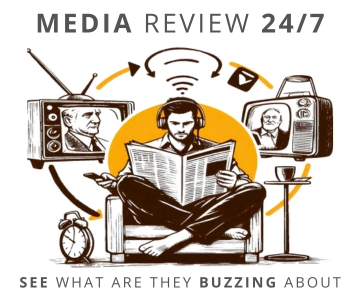- The total number of ad impressions is approximately 370 million,
- affluent individuals account for 28.4 million impressions,
- individuals in managerial positions generate 7.4 million impressions.
 Source: PBC
Source: PBCAnother key metric is ad engagement. According to PBC, print ads are highly engaging and difficult to overlook.
- 86% of readers notice print advertisements,
- the average visual contact with an ad lasts 8 seconds,
- each reader has an average of 13 ad impressions.
Trust is another factor highlighted by the study, with print advertising scoring high in this regard.
- 77% of readers consider the press a reliable medium,
- 63% find print ad content useful,
- 26% are willing to pay for access to online press content.
PBC`s reports are based on eyetracking studies covering both daily newspapers and magazines. Detailed information on the effectiveness of advertising in the most popular press titles was published in early 2021.
COMMERCIAL BREAK
New articles in section Media industry
Advertising market 2025. Poland, Europe and the World
Marcin Grządka
The global advertising market is growing by 8.8% in 2025 and will reach a value of 1.14 trillion dollars. The industry result in Europe records slightly lower dynamics, at the level of 5.8%. In this comparison, Poland performs clearly above the average. We will record an increase of 8.9% this year and a value of 18.56 billion PLN - estimates WPP Media in the annual report "This Year Next Year".
The print media market 2025. Three global trends
Krzysztof Fiedorek
The market value is 359.53 billion dollars, yet the erosion is visible to the naked eye. The decline for newspapers will amount to -2.3 percent. Despite this, print retains strength: it generates 76 percent of subscription revenues and enjoys 82 percent consumer trust. The future of the industry is defined by hybrid strategies and niche specialization.
Journalism in the age of AI. Why people prefer humans over machines
Krzysztof Fiedorek
Only 12% of people accept news created solely by AI, while 62% prefer those written by humans. At the same time, only 19% notice labels indicating the use of artificial intelligence, while younger audiences ask AI to explain the content to them. These are the findings of the Reuters Institute report on artificial intelligence in media.
See articles on a similar topic:
Music for Overstimulated Children: Research from Polish Kindergartens
OOO
Hyperactivity, impatience, and difficulties with concentration are increasingly common challenges faced by preschool and school-aged children. An excess of stimuli, including digital ones, makes it hard for children to focus on a single task. Is there anything that can be done about it?
Clickbait Uncovered. How Online Headlines Evolved Over 25 Years
Krzysztof Fiedorek
Researchers from the Max Planck Institute analyzed 40 million headlines from the past 25 years. They are getting longer, more emotional, and negative, with a clear influence of clickbait style. Even reputable media use strategies and tricks to grab attention.
Numbers Stations in Radio. For Puzzle and Cryptography Enthusiasts
Krzysztof Fiedorek
They broadcast seemingly meaningless strings of numbers and letters, sometimes short, encrypted messages. Some even play music between coded transmissions or broadcast propaganda. For over a hundred years, number stations have puzzled radio enthusiasts and mystery hunters. What do we know about them?
First Trillion Dollars. Advertising Market 2024 and Forecasts for 2025
DUG
GroupM, in its cyclical report "This Year Next Year," summarizing the past year and predicting trends for the next, has published the latest forecasts for global advertising markets. The estimated advertising market growth rate in 2024 is as high as 9.5%, bringing its value globally to over 1 trillion dollars.





























